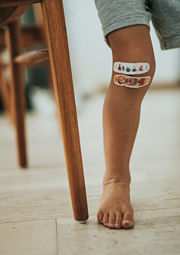How Virtual Friendships Are Redefining Emotional Growth in Children
Once, when the author of this article was much younger, kids learned the rules of friendship on the playground. Today, things are a bit different, and smartphone and laptop screens are there to mediate many of their connections. While it’s too easy to dismiss this as a cold substitute for what we perceive as real interaction, virtual friendships are taking hold.
How virtual friendships are redefining emotional growth in children becomes much clearer when we take a closer look at the emotional literacy these bonds inspire and the new modes of connection, they help form.
Besides taking hold, they’re also redefining emotional growth in children. They uncover the subtleties and shifts that have snuck in, unnoticed, behind the blue glow of a screen. While some adults might feel unease regarding this shift, worried about their kids’ upbringing, often negatively comparing it to their own (an upbringing that’s often a little mythologized), research suggests that children are quickly adapting to this new form of connection and – what’s more important – their emotional growth isn’t being stunted by online communication. Therefore, let’s begin!
Children and virtual friendships
Back in the day, friendship used to be closely tied to the idea of proximity. That kid across the street who liked the same cartoon as you did, or the shy one who you were randomly placed next to in class on the first day of school. Well, these fellas became your friends almost by default. Now, proximity hasn’t got much to do with it, as friendships form across continents and oceans.
Yet, regardless of what some “discussion-oriented” individual at your family gathering thinks, the emotional bonds created are real, just as anything in the world. Children are learning and developing various social skills, EVEN when communicating online. There are facts to back this up. A study of children’s perspectives on friendships and socialization found that these virtual friendships help children develop empathy and cooperation. However, in (slightly) different forms from those we’re used to.
An example right out of the textbook
Take the video games where kids work together to complete missions. We can imagine that the emotional dynamics are just as complex as any schoolyard argument. Kids learn to build trust, work as part of a bigger team, manage disappointment, and work on similar skills we usually associate with face-to-face interaction.
However, there’s something deeper at play. Virtual friendships introduce children to a world where emotional communication happens differently. They don’t get to read facial expressions. They read texts, emojis, memes. While this has its drawbacks, it also develops a new type of emotional literacy. It thrives in the digital age and will continue to do so in the future.
 Virtual friendships introduce children to a world where emotional communication happens differently than in the so-called real world.
Virtual friendships introduce children to a world where emotional communication happens differently than in the so-called real world.How virtual friendships are redefining emotional growth in children
In our hyperconnected world, children are learning a little something about distance. Virtual friendships teach them that emotional bonds aren’t – as we’ve already noted – bound to how many (kilo)meters or miles exist between them and their buddies.
For some children, the distance can be liberating. It can act as a buffer that helps them open up in ways they might struggle with face-to-face. This often reveals the subtle difference between anxiety and shyness. Social anxiety is usually about a deeper fear of being judged, while shyness mostly just refers to hesitation in new situations. This is a distinction parents and mental health experts can better recognize and address.
By communicating via the internet, children can talk about their days and emotions to someone thousands of miles away. This someone mightn’t speak their language fluently but still understands shared symbols of their (digital) interactions. The smiley-face emoji, the one with the handlebar mustache (usually representing a nagging parent), and a simple heart emoji all go a long way. It’s a sign system, a rudimentary language. Additionally, it’s universal, much like (reading) facial expressions in humans (many of which are actually mirrored in emojis).
Learning empathy in a different light (1)
Empathy has traditionally been taught through direct, face-to-face interaction – seeing someone’s tears, hearing their voice crack. But in the virtual world, children have found fresh ways to develop empathy. Even though it might seem a bit counterintuitive, typing “u okay?” can carry some solid emotional weight. An emoji, timed just right, can say what a hug might be. What’s more, today’s youth are picking up on nuances in language and tone that adults often miss; they’re sharpening a freshly built emotional radar.
The resilience of digital bonds (2)
Virtual friendships became havens for many during the COVID-19 pandemic when face-to-face communication was unexpectedly and violently interrupted. This was especially important for many children. While some parents feared this would result in a generation of socially awkward kids who don’t know how to communicate with each other, the opposite happened, as virtual friendships allowed children to maintain a sense of normalcy. Moreover, these relationships taught them resilience they might’ve never learned another way.
Unlike fleeting in-person interactions that might dissolve after the school bell rings, virtual friendships often require a sustained effort. There’s something to be said about the resilience a child develops when maintaining a connection with someone they can’t physically meet. They learn to deal with disagreements without dramatically storming off, sustain a conversation despite delays in responses, and remain patient when weak Wi-Fi disrupts their communication.
The (ever-present) question of presence (3)
Lastly – or, well, yet again – there’s the question of presence in our story about how virtual friendships are redefining emotional growth in children. Can we truly say a virtual friend is present in the way a friend sitting beside you is? This is where the distinction between old and new models of friendship becomes clearest, a distinction many adults like to fight about.
For these kids, presence has become independent of physicality. It’s the reply to a message, the shared silence of being online together but saying nothing. In these quiet moments, something significant occurs when there’s nothing but a glowing screen and a sense that someone else is on the other side of it. An awareness that presence can be felt, not through touch, but through an abstract, almost psychic understanding that someone else is there. In this way, virtual friendships teach children that presence isn’t always about bodies. It’s about attention, about showing up in whatever form it takes.
Conclusion
The conversation around how virtual friendships are redefining emotional growth in children is one we can’t afford to stop having. Not because we have it all figured out but precisely because we don’t. There’s no definitive answer to whether these friendships are better or worse than those of the past. But that’s beside the point. The point is that they exist.
Emotional development isn’t a static concept, nor does it adhere to a single mode of connection. Today’s children are mastering social skills in ways that were unimaginable just a generation ago. By blending the real and the virtual, they’re forging emotional literacies that reinvent empathy and presence in ways we’re still learning to understand. It’s a new kind of growing up, measured in keyboard taps and the glow of screens. But make no mistake – it’s still the same old coming-of-age story with a slightly different narrator.








